2013 Hyundai Santa Fe power steering
[x] Cancel search: power steeringPage 16 of 711
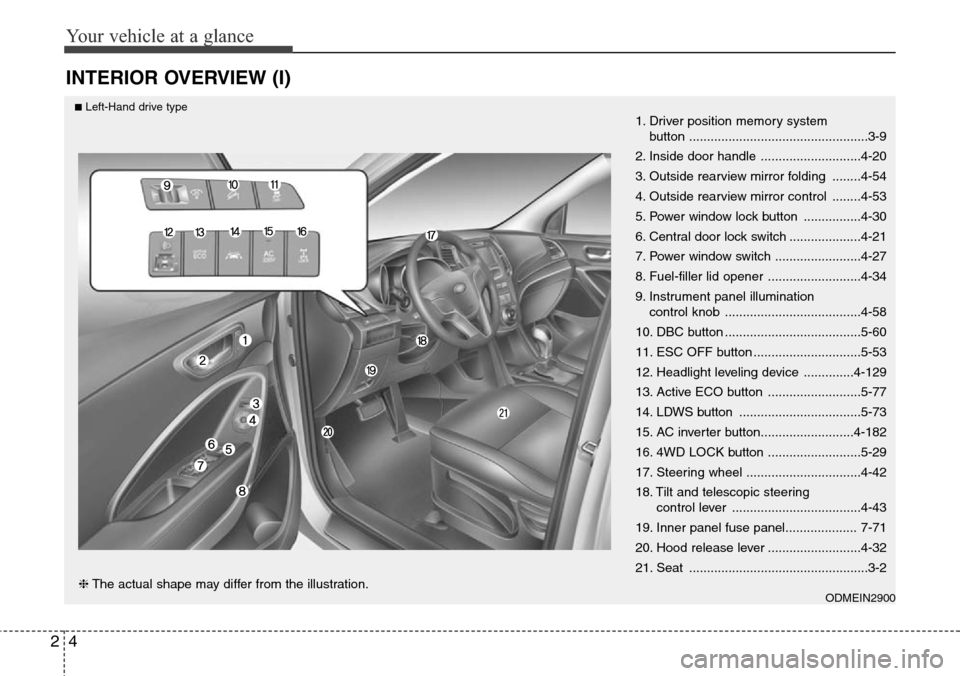
Your vehicle at a glance
4 2
INTERIOR OVERVIEW (I)
1. Driver position memory system
button ..................................................3-9
2. Inside door handle ............................4-20
3. Outside rearview mirror folding ........4-54
4. Outside rearview mirror control ........4-53
5. Power window lock button ................4-30
6. Central door lock switch ....................4-21
7. Power window switch ........................4-27
8. Fuel-filler lid opener ..........................4-34
9. Instrument panel illumination
control knob ......................................4-58
10. DBC button ......................................5-60
11. ESC OFF button ..............................5-53
12. Headlight leveling device ..............4-129
13. Active ECO button ..........................5-77
14. LDWS button ..................................5-73
15. AC inverter button..........................4-182
16. 4WD LOCK button ..........................5-29
17. Steering wheel ................................4-42
18. Tilt and telescopic steering
control lever ....................................4-43
19. Inner panel fuse panel.................... 7-71
20. Hood release lever ..........................4-32
21. Seat ..................................................3-2
ODMEIN2900❈The actual shape may differ from the illustration.
■Left-Hand drive type
Page 17 of 711
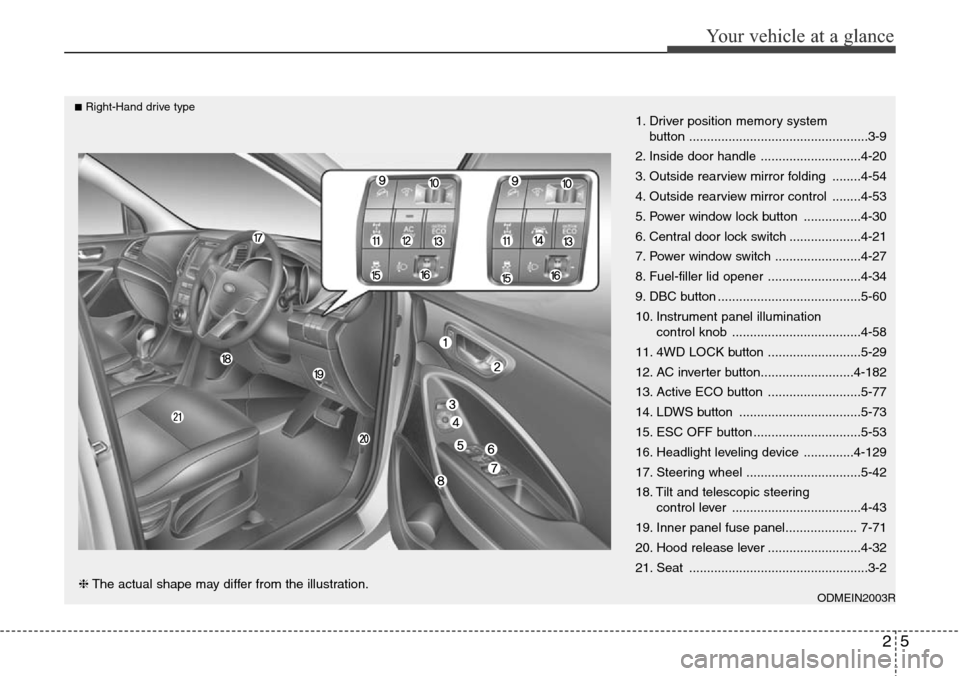
25
Your vehicle at a glance
1. Driver position memory system
button ..................................................3-9
2. Inside door handle ............................4-20
3. Outside rearview mirror folding ........4-54
4. Outside rearview mirror control ........4-53
5. Power window lock button ................4-30
6. Central door lock switch ....................4-21
7. Power window switch ........................4-27
8. Fuel-filler lid opener ..........................4-34
9. DBC button ........................................5-60
10. Instrument panel illumination
control knob ....................................4-58
11. 4WD LOCK button ..........................5-29
12. AC inverter button..........................4-182
13. Active ECO button ..........................5-77
14. LDWS button ..................................5-73
15. ESC OFF button ..............................5-53
16. Headlight leveling device ..............4-129
17. Steering wheel ................................5-42
18. Tilt and telescopic steering
control lever ....................................4-43
19. Inner panel fuse panel.................... 7-71
20. Hood release lever ..........................4-32
21. Seat ..................................................3-2
ODMEIN2003R❈The actual shape may differ from the illustration.
■Right-Hand drive type
Page 23 of 711
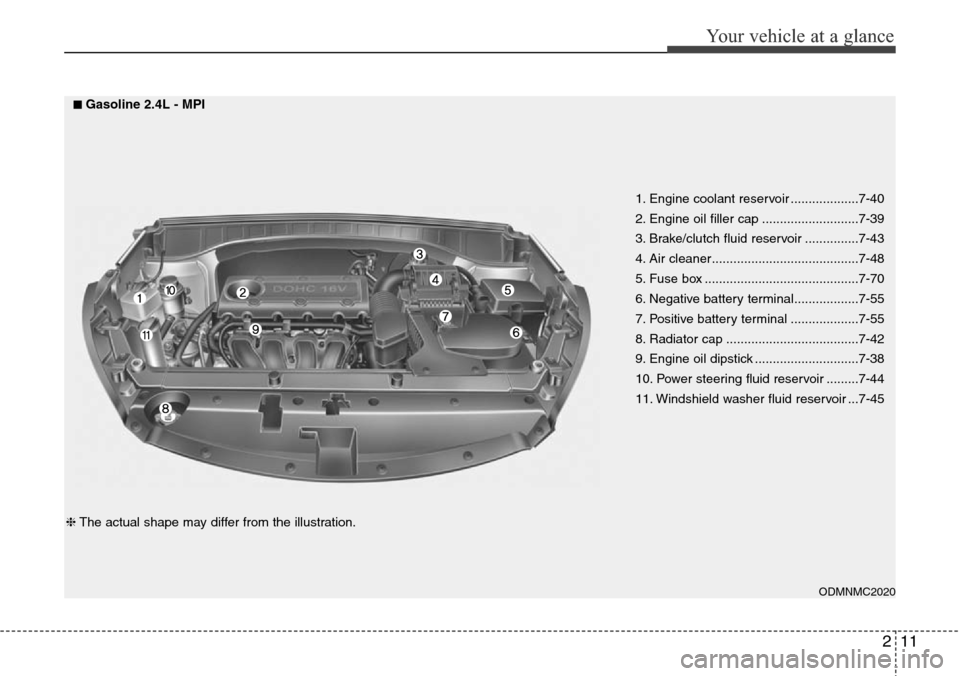
211
Your vehicle at a glance
1. Engine coolant reservoir ...................7-40
2. Engine oil filler cap ...........................7-39
3. Brake/clutch fluid reservoir ...............7-43
4. Air cleaner.........................................7-48
5. Fuse box ...........................................7-70
6. Negative battery terminal..................7-55
7. Positive battery terminal ...................7-55
8. Radiator cap .....................................7-42
9. Engine oil dipstick .............................7-38
10. Power steering fluid reservoir .........7-44
11. Windshield washer fluid reservoir ...7-45
ODMNMC2020
■Gasoline 2.4L - MPI
❈The actual shape may differ from the illustration.
Page 24 of 711
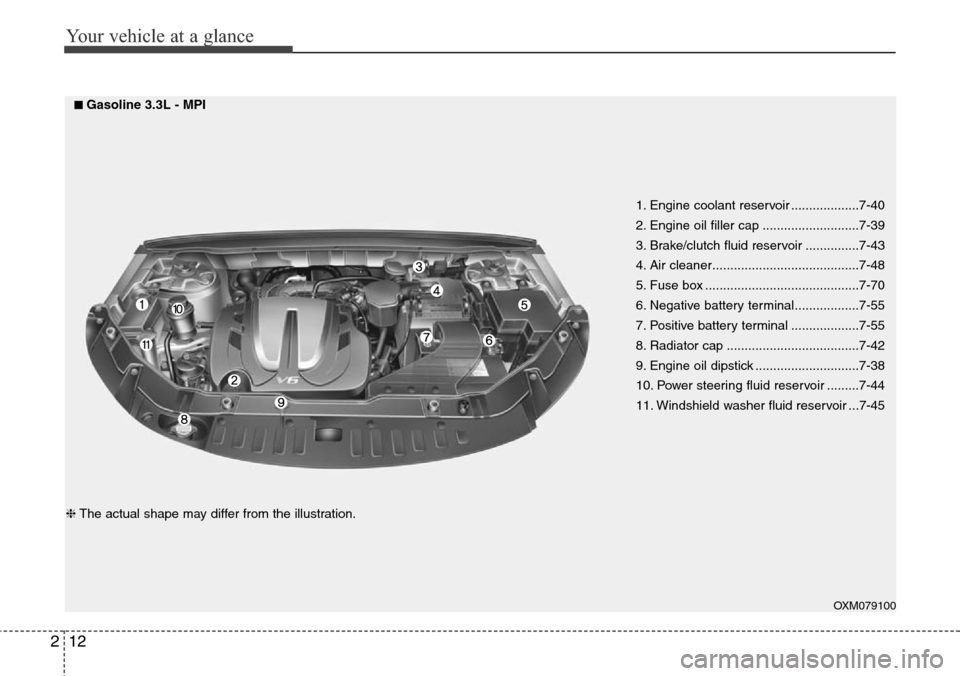
Your vehicle at a glance
12 2
OXM079100
1. Engine coolant reservoir ...................7-40
2. Engine oil filler cap ...........................7-39
3. Brake/clutch fluid reservoir ...............7-43
4. Air cleaner.........................................7-48
5. Fuse box ...........................................7-70
6. Negative battery terminal..................7-55
7. Positive battery terminal ...................7-55
8. Radiator cap .....................................7-42
9. Engine oil dipstick .............................7-38
10. Power steering fluid reservoir .........7-44
11. Windshield washer fluid reservoir ...7-45
■Gasoline 3.3L - MPI
❈The actual shape may differ from the illustration.
Page 32 of 711
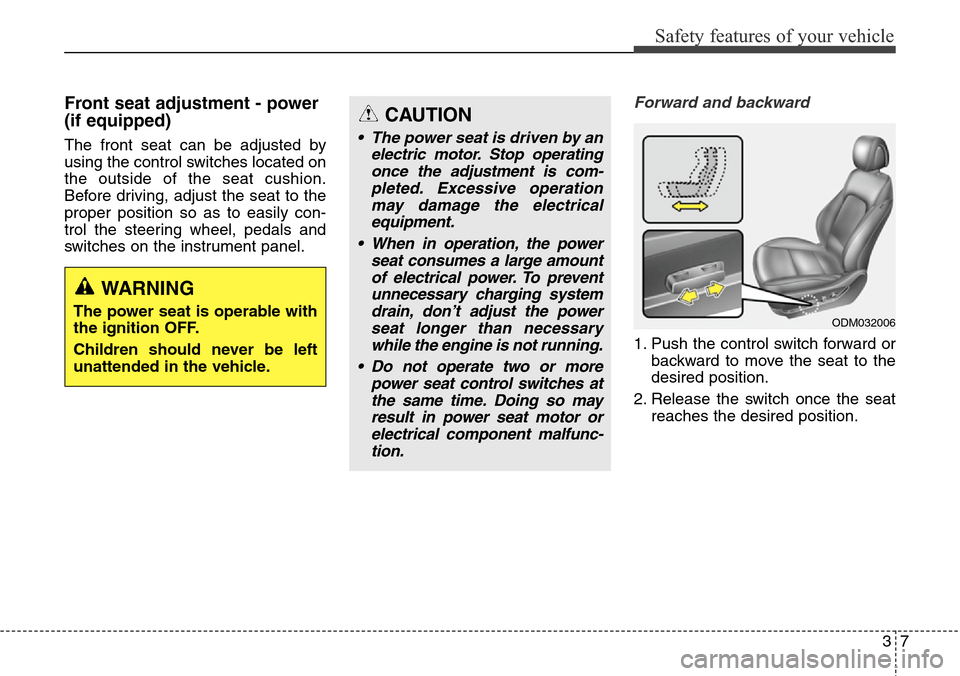
37
Safety features of your vehicle
Front seat adjustment - power
(if equipped)
The front seat can be adjusted by
using the control switches located on
the outside of the seat cushion.
Before driving, adjust the seat to the
proper position so as to easily con-
trol the steering wheel, pedals and
switches on the instrument panel.
Forward and backward
1. Push the control switch forward or
backward to move the seat to the
desired position.
2. Release the switch once the seat
reaches the desired position.
CAUTION
• The power seat is driven by an
electric motor. Stop operating
once the adjustment is com-
pleted. Excessive operation
may damage the electrical
equipment.
• When in operation, the power
seat consumes a large amount
of electrical power. To prevent
unnecessary charging system
drain, don’t adjust the power
seat longer than necessary
while the engine is not running.
• Do not operate two or more
power seat control switches at
the same time. Doing so may
result in power seat motor or
electrical component malfunc-
tion.
WARNING
The power seat is operable with
the ignition OFF.
Children should never be left
unattended in the vehicle.ODM032006
Page 102 of 711
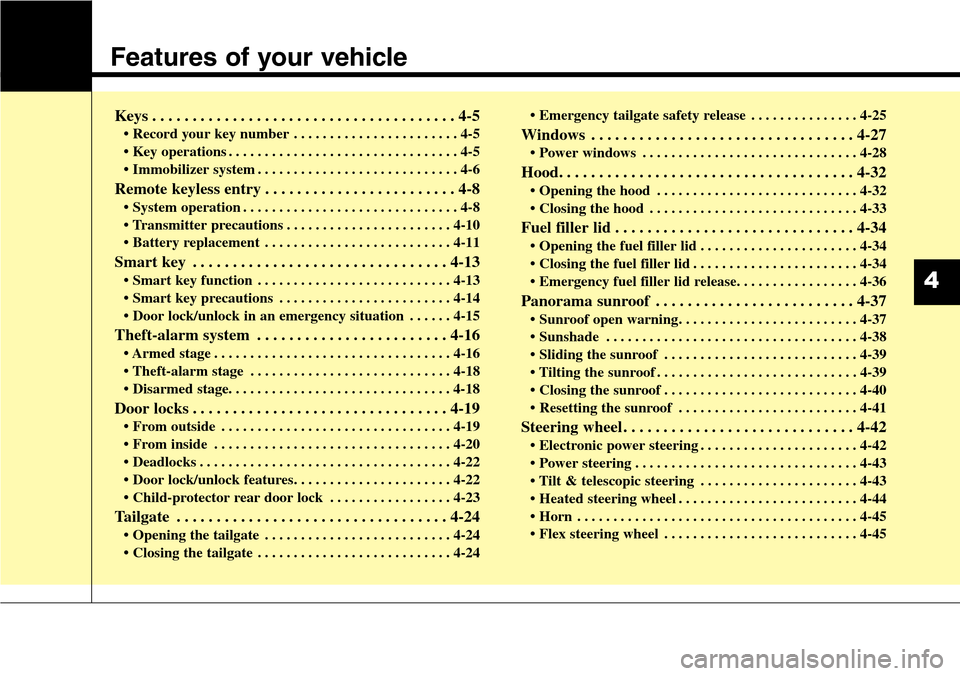
Features of your vehicle
Keys . . . . . . . . . . . . . . . . . . . . . . . . . . . . . . . . . . . . . . 4-5
• Record your key number . . . . . . . . . . . . . . . . . . . . . . . 4-5
• Key operations . . . . . . . . . . . . . . . . . . . . . . . . . . . . . . . . 4-5
• Immobilizer system . . . . . . . . . . . . . . . . . . . . . . . . . . . . 4-6
Remote keyless entry . . . . . . . . . . . . . . . . . . . . . . . . 4-8
• System operation . . . . . . . . . . . . . . . . . . . . . . . . . . . . . . 4-8
• Transmitter precautions . . . . . . . . . . . . . . . . . . . . . . . 4-10
• Battery replacement . . . . . . . . . . . . . . . . . . . . . . . . . . 4-11
Smart key . . . . . . . . . . . . . . . . . . . . . . . . . . . . . . . . 4-13
• Smart key function . . . . . . . . . . . . . . . . . . . . . . . . . . . 4-13
• Smart key precautions . . . . . . . . . . . . . . . . . . . . . . . . 4-14
• Door lock/unlock in an emergency situation . . . . . . 4-15
Theft-alarm system . . . . . . . . . . . . . . . . . . . . . . . . 4-16
• Armed stage . . . . . . . . . . . . . . . . . . . . . . . . . . . . . . . . . 4-16
• Theft-alarm stage . . . . . . . . . . . . . . . . . . . . . . . . . . . . 4-18
• Disarmed stage. . . . . . . . . . . . . . . . . . . . . . . . . . . . . . . 4-18
Door locks . . . . . . . . . . . . . . . . . . . . . . . . . . . . . . . . 4-19
• From outside . . . . . . . . . . . . . . . . . . . . . . . . . . . . . . . . 4-19
• From inside . . . . . . . . . . . . . . . . . . . . . . . . . . . . . . . . . 4-20
• Deadlocks . . . . . . . . . . . . . . . . . . . . . . . . . . . . . . . . . . . 4-22
• Door lock/unlock features. . . . . . . . . . . . . . . . . . . . . . 4-22
• Child-protector rear door lock . . . . . . . . . . . . . . . . . 4-23
Tailgate . . . . . . . . . . . . . . . . . . . . . . . . . . . . . . . . . . 4-24
• Opening the tailgate . . . . . . . . . . . . . . . . . . . . . . . . . . 4-24
• Closing the tailgate . . . . . . . . . . . . . . . . . . . . . . . . . . . 4-24• Emergency tailgate safety release . . . . . . . . . . . . . . . 4-25
Windows . . . . . . . . . . . . . . . . . . . . . . . . . . . . . . . . . 4-27
• Power windows . . . . . . . . . . . . . . . . . . . . . . . . . . . . . . 4-28
Hood. . . . . . . . . . . . . . . . . . . . . . . . . . . . . . . . . . . . . 4-32
• Opening the hood . . . . . . . . . . . . . . . . . . . . . . . . . . . . 4-32
• Closing the hood . . . . . . . . . . . . . . . . . . . . . . . . . . . . . 4-33
Fuel filler lid . . . . . . . . . . . . . . . . . . . . . . . . . . . . . . 4-34
• Opening the fuel filler lid . . . . . . . . . . . . . . . . . . . . . . 4-34
• Closing the fuel filler lid . . . . . . . . . . . . . . . . . . . . . . . 4-34
• Emergency fuel filler lid release. . . . . . . . . . . . . . . . . 4-36
Panorama sunroof . . . . . . . . . . . . . . . . . . . . . . . . . 4-37
• Sunroof open warning. . . . . . . . . . . . . . . . . . . . . . . . . 4-37
• Sunshade . . . . . . . . . . . . . . . . . . . . . . . . . . . . . . . . . . . 4-38
• Sliding the sunroof . . . . . . . . . . . . . . . . . . . . . . . . . . . 4-39
• Tilting the sunroof . . . . . . . . . . . . . . . . . . . . . . . . . . . . 4-39
• Closing the sunroof . . . . . . . . . . . . . . . . . . . . . . . . . . . 4-40
• Resetting the sunroof . . . . . . . . . . . . . . . . . . . . . . . . . 4-41
Steering wheel . . . . . . . . . . . . . . . . . . . . . . . . . . . . . 4-42
• Electronic power steering . . . . . . . . . . . . . . . . . . . . . . 4-42
• Power steering . . . . . . . . . . . . . . . . . . . . . . . . . . . . . . . 4-43
• Tilt & telescopic steering . . . . . . . . . . . . . . . . . . . . . . 4-43
• Heated steering wheel . . . . . . . . . . . . . . . . . . . . . . . . . 4-44
• Horn . . . . . . . . . . . . . . . . . . . . . . . . . . . . . . . . . . . . . . . 4-45
• Flex steering wheel . . . . . . . . . . . . . . . . . . . . . . . . . . . 4-45
4
Page 143 of 711

Features of your vehicle
42 4
Electronic power steering
(if equipped)
Power steering uses the motor to
assist you in steering the vehicle. If
the engine is off or if the power steer-
ing system becomes inoperative, the
vehicle may still be steered, but it will
require increased steering effort.
The motor driven power steering is
controlled by the power steering con-
trol unit which senses the steering
wheel torque and vehicle speed to
command the motor.
The steering wheel becomes heavier
as the vehicle’s speed increases and
becomes lighter as the vehicle’s
speed decreases for better control of
the steering wheel.
Should you notice any change in the
effort required to steer during normal
vehicle operation, we recommend
that the system be checked by
authorized HYUNDAI dealer.
✽NOTICE
The following symptoms may occur
during normal vehicle operation:
• The EPS warning light does not
illuminate.
• The steering effort is high immedi-
ately after turning the ignition
switch on. This happens as the sys-
tem performs the EPS system
diagnostics. When the diagnostics
is completed, the steering wheel
will return to its normal condition.
• A click noise may be heard from
the EPS relay after the ignition
switch is turned to the ON or
LOCK/OFF position.
• Motor noise may be heard when
the vehicle is at a stop or at a low
driving speed.
• The steering effort increases if the
steering wheel is rotated continu-
ously when the vehicle is not in
motion. However, after a few min-
utes, it will return to its normal
conditions.
(Continued)(Continued)
• If the Electronic Power Steering
System does not operate normally,
the warning light will illuminate on
the instrument cluster. The steer-
ing wheel may become difficult to
control or operate abnormally. We
recommend that you contact an
authorized HYUNDAI dealer.
• When you operate the steering
wheel in low temperature, abnor-
mal noise could occur. If tempera-
ture rises, the noise will disappear.
This is a normal condition.
STEERING WHEEL
Page 144 of 711

443
Features of your vehicle
Power steering (if equipped)
Power steering uses energy from the
engine to assist you in steering the
vehicle. If the engine is off or if the
power steering system becomes
inoperative, the vehicle may still be
steered, but it will require increased
steering effort.
Should you notice any change in the
effort required to steer during normal
vehicle operation, we recommend
that the system be checked by an
authorized HYUNDAI dealer.
✽NOTICE
If the power steering drive belt
breaks or if the power steering
pump malfunctions, the steering
effort will greatly increase.
✽NOTICE
If the vehicle is parked for extended
periods outside in cold weather
(below -10°C/14°F), the power steer-
ing may require increased effort
when the engine is first started. This
is caused by increased fluid viscosity
due to the cold weather and does not
indicate a malfunction.
When this happens, increase the
engine RPM by depressing accelera-
tor until the RPM reaches 1,500 rpm
then release or let the engine idle for
two or three minutes to warm up the
fluid.
Tilt steering
A tilt steering wheel allows you to
adjust the steering wheel before you
drive. You can also raise it to give
your legs more room when you exit
and enter the vehicle.
The steering wheel should be posi-
tioned so that it is comfortable for
you to drive, while permitting you to
see the instrument panel warning
lights and gauges.
CAUTION
Never hold the steering wheel
against a stop (extreme right or
left turn) for more than 5 sec-
onds with the engine running.
Holding the steering wheel for
more than 5 seconds in either
position may cause damage to
the power steering pump.
WARNING
• Never adjust the angle and
height of steering wheel while
driving. You may lose your
steering control and cause
severe personal injury or acci-
dents.
• After adjusting, push the
steering wheel both up and
down to be certain it is locked
in position.